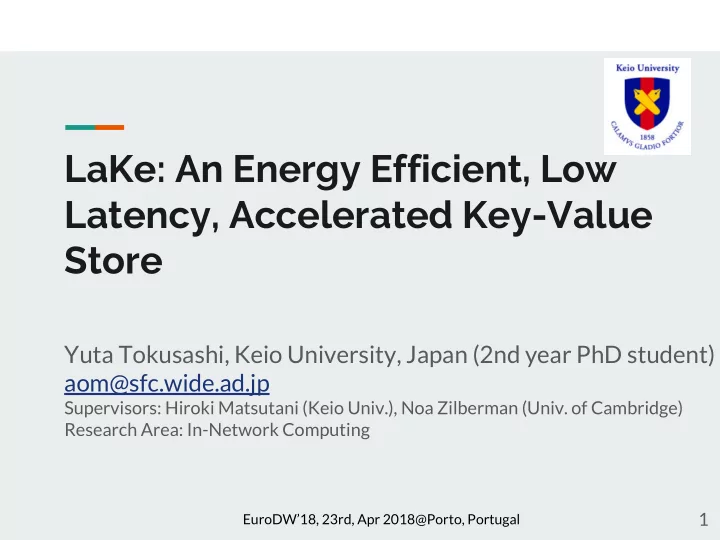

LaKe: An Energy Efficient, Low Latency, Accelerated Key-Value Store Yuta Tokusashi, Keio University, Japan (2nd year PhD student) aom@sfc.wide.ad.jp Supervisors: Hiroki Matsutani (Keio Univ.), Noa Zilberman (Univ. of Cambridge) Research Area: In-Network Computing 1 EuroDW’18, 23rd, Apr 2018@Porto, Portugal
LaKe: Key-Value Store (KVS) made better ★ Networked applications (e.g., KVS) are inefficient due to power hungry CPUs. ★ Applications’ performance needs to scale, but is limited by power. ★ LaKe: Scalable in-network KVS using cache hierarchy. ★ Energy efficiency: x24 better than software KVS, x5.1 better than hardware KVS . 2
Datacenter for Networked Systems Power Consumption Gap between networking and Computing CPU is power-hungry Computation growth is moderate, compared to networking. Datacenter applications should be improved in terms of Power and Performance . Power Efficiency is important!!! 3 [RSTA’16] Noa Zilberman, et al. “From photons to big-data applications: terminating terabits”. Royal Society Philosophical Transactions, March 2016.
Highly energy efficient KVS Lake: Layered Key-value store Main Storage < 10 TB memcached On-board DRAM (host memory, HDD) L2 Cache In-kernel KVS < 100s GB Shared-cache (host memory) L1 Cache < 16GB PE0 In-NIC KVS (on-board DRAM) Client 4
LaKe: Layered Key-value Store 5
Comparison with related work System Latency [us] Tput [Mqps] Power Efficiency i7-4770 + Memcached (SW) 238.84 0.962 9.938 [kqps/W] MellanoxNIC Emu (HW) 1.21 1.932 47.121 i7-4770 + x5.1 NetFPGA- LaKe (my system) 1.16 13.120 242.962 SUME (5PE totally) LaKe achieves x5.1 better power efficiency, keeping latency equivalent to Emu. 6
Q & A Thank you for your attention!! 7
Acknowledgement This work is supported by JSPS Research Fellowship, The Leverhulme Trust and Isaac Newton Trust. 8
Recommend
More recommend